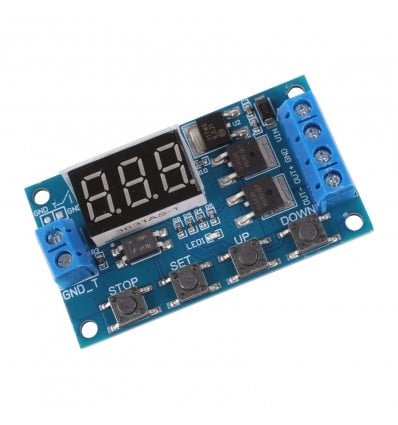International shipping Secure payment
No products
Prices are tax included
Product successfully added to your shopping cart
There are 0 items in your cart. There is 1 item in your cart.
1 Channel 5V Timer Relay - 15A/36VDC, Continuous Timing
9MTIMERSWT
New
This handy 5V Timer Relay lets you automate projects, switching them on and off in cycles of as low as 0.1 seconds to as high as 999 minutes.
5+ In Stock Items
Warning: Last items in stock!
Free shipping on orders over R1250 - courier delivery and within South Africa
Relays are certainly awesome tools for almost any Electronics enthusiast, whether you’re working with high AC powered devices and are looking for a way to isolate the controls, or whether you simply like experimenting with and prototyping automation projects. However, if you really want to step up your game, but without involving microcontrollers like Arduino Boards or similar dev’ platforms, then this 1 Channel 5V Cycle Timer Relay is the perfect tool to help you do just that, offering 15A/36VDC switching capabilities and a low 5V control, and packed full of fantastic features that really let you customise your switching and relay projects with precision.
While we like to call these boards “Relay Modules” to make it easier to understand what they do, these boards are in fact Dual-MOS Switching modules, although they work in almost exactly the same way that typical Solid State Relays would. They utilise two powerful MOSFETs driven by some clever IC circuitry, and feature a built in 7 Segment display unit with an integrated RTC clock for various timing modes and pre-calibrated time-based functionality. This completely removes the need for any kinds of MCU’s from your project, as you can simply choose the correct mode that you want (more details about the various modes below) and then calibrate specific on and off times, as well as the number of times (or cycles) that you want the boards to repeat the process. And while we can definitely see a lot of cool automation projects coming from these fancy little Modules, they can realistically be used for pretty much any applications in which timed switching is a key function – from automated cupboard lighting to specialised processes in cooking, industry or other exciting fields of expertise.
1 Channel 5V Timed Cycle Relay Module - Technical Specifications: |
|
|
– 1 |
|
– Solid State / Dual-MOS Parallel Drive |
|
– 5V to 36V DC |
|
– 5V to 36V DC @ ≤15A |
|
– 400W |
|
– 3V to 24V DC |
|
– OP: Operating Time / ON Time – CL: Disconnect Time / OFF Time – LOP: Number of Cycles / Frequency |
|
– XXX. : 1 Second to 999 Seconds – XX.X : 0.1 Second to 99.9 Seconds – X.X.X. : 1 Minute to 999 Minutes |
|
– STOP | SET | UP | DOWN |
|
– Momentary Press “STOP” Button |
|
– Hold “STOP” Button for ≥2 Seconds |
|
– Hold “DOWN” Button for ≥2 Seconds |
|
– 3x7 Segment Display (With Decimal Point) – Switch “ENABLE” LED |
The Many Different Modes of the 5V Cycle Timer Relay Module:
Although this module may seem rather basic at first, there are actually some really cool features built into the circuit that really let you precisely define how this module should work. It offers four distinctly unique Operation Modes to cater to all kinds of different applications, three different Timing Modes to support various timeframes of operation, and even a reverse functionality mode (Hold DOWN for 2 seconds before releasing) that essentially switches the open/close terminals so that the module operates in reverse, turning the switch on when it’s supposed to be off, and off when it’s supposed to be on.
These various modes and features all culminate into a truly extraordinary board that offers way more functionality than one would ever imagine when looking at it. So let’s take a few minutes to explore these different modes and functions, so that you can hit the ground running and get your projects working precisely as planned, with as little confusion or hassle as possible.
Module Controls and Interfacing:
In order to really take advantage of the full feature set of this awesome module, it’s best to choose the exact mode that best caters to your particular project needs. This mode can be selected directly after powering up the module, and simply requires that you press and hold the “SET” button for two seconds. After holding “SET”, the module should begin to display modes on the 7 Segment Display unit, allowing you to select between the modes (featured below) by pressing the “UP” and “DOWN” buttons.
Once you’ve chosen the mode you want, short-press the “SET” button to start defining the parameters, with “OP” (or On Time) appearing first, “CL” (Down Time) appearing second, and “LOP” (Cycles/frequency) appearing third. During this setup, you can also use the “STOP” button to select the decimal position so as to define the time range (from 0.1 seconds to 999 minutes) that you would like to use, until you are done calibrating all three variables for whatever mode you selected. And then finally, once you’ve chosen the operation mode and defined the three timing variables, simply press and hold the “SET” button again for two seconds to exit back to the standard interface, after which the module should work as per your calibration for whatever project or application you’re using it for.
Modes of Operation:
P1: This is the standard mode of operation that many would agree is the intuitive way of using modules like these. It is split into three sub-modes (P1.1, P1.2 and P1.3) and in all three sub-modes operates on the basis of turning on for “OP” time and then turning off for “CL” time – for a predefined number of cycles “LOP”. These sub-modes are as follows:
P1.1: This should be the default setting of the module when you get it (although sometimes it may be set to another mode from factory calibration) and operates precisely as stated above, but disables the signal trigger until after all of the cycles are complete. This is a very standard way of operating, and essentially just acts as a programmable timing relay, allowing you to choose on and off times, as well as the number of times the cycle repeats.
P1.2: This next sub-mode is very similar to P1.1, but allows for the signal trigger to be used to reset the clock. This is great, as it offers relatively standard operations, but lets you tweak the timer as you need to, allowing for on-the-fly readjustments without having to recalibrate the timers.
P1.3: This final sub-mode of P1 operation is similar to the both of the sub-modes listed above, but utilises the signal trigger as a stop function, turning off the relay and stopping clock when a signal is presented. This is perfect for reactionary processes, as you can ensure that once a certain sensor is activated, or when another criterion is met, the current cycle of the relay module stops immediately.
P2: The next operating mode focuses more on waiting a certain amount of time before activating for a secondary amount of time, before finally turning off again. When the signal is triggered, the module will wait for “CL” time, and then after that time period is done, it will turn on for “OP” time, after which it will disconnect and await the next signal trigger. This is particularly beneficial for automation systems, processing, cooking and many other use cases, and this can also then be tied into larger systems so as to streamline and precisely time various processes within an operation.
P3.1: This third major operating mode is essentially a blend of P1.3 and P2 modes. When a signal is triggered, the relay will stay off for “OP” time, before turning on for “CL” time, and then once again turning off and repeating for “LOP” number of times. However, at any stage during this procedure, if a signal is triggered again, then it immediately ends that cycle and begins the next cycle. This is an ideal solution for applications like refrigeration or lighting, which may need to begin a new cycle each time a door is opened or a similar action is taken, while maintaining a reliable and predictable mode of operations.
P3.2: This next mode of operation is quite a standard mode compared to the previous, and essentially offers the same function as P1, although instead of just turning on and off once, it will continue to do so for “LOP” number of cycles. Of course, if you define “LOP” to be “---”, then as stated in the table above, the cycle will continue indefinitely. However, if you would like the process to run a specific number of times before awaiting further instructions, then “LOP” can be set to the precise number of times that you need.
P4: The final trigger mode is designed more for automation rather than timed cycles, and is called the “Signal Holding Function”. With this mode, the relay switch module will turn on while a signal is present on the control terminal. Then, once the signal ends, the module will continue to stay on for “OP” time before turning off indefinitely. This state will last until a signal is present on the control terminal again, at which point it will wait for the signal to end and then start the “OP” timer again. This is particularly beneficial for projects like automated lighting, in which you want the lights to turn on (and stay on) for X amount of time each time a door is opened, a sensor is activated, or after a button is pressed.
Additional Reosources:
- Finally, if you're still struggling to wrap your head around this awesome but quite complex module, check out this Handy Cycle Timer Relay Tutorial. Although the board itself is different in design, the functionality is extremely similar, so it's worth taking a look, especially regarding the mode selections and operations in the second half of the video.
No customer reviews for the moment.





